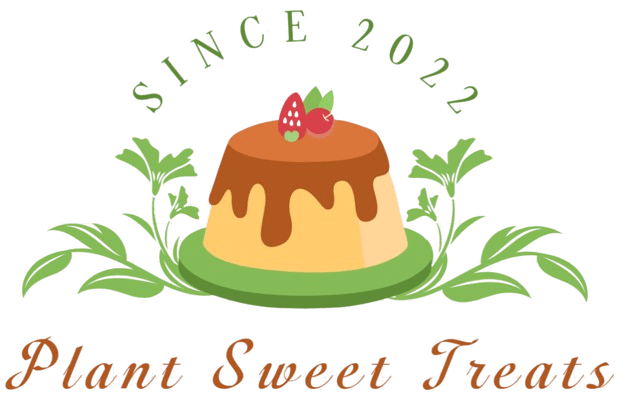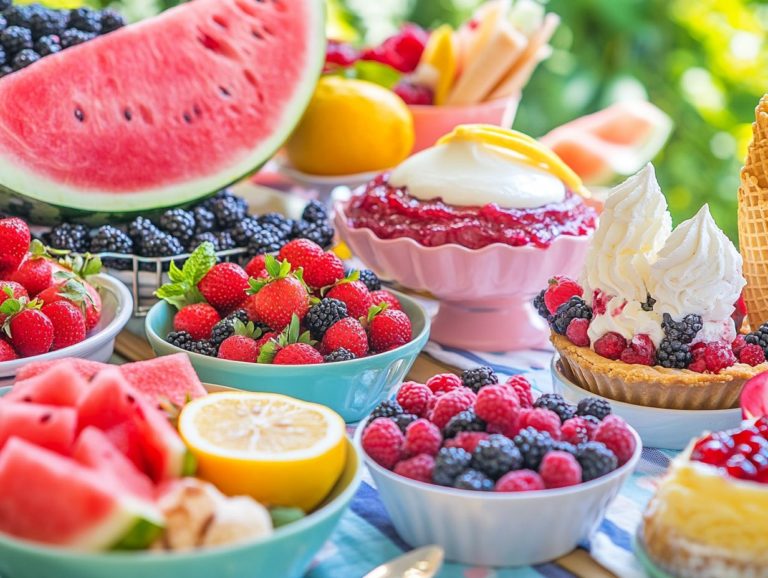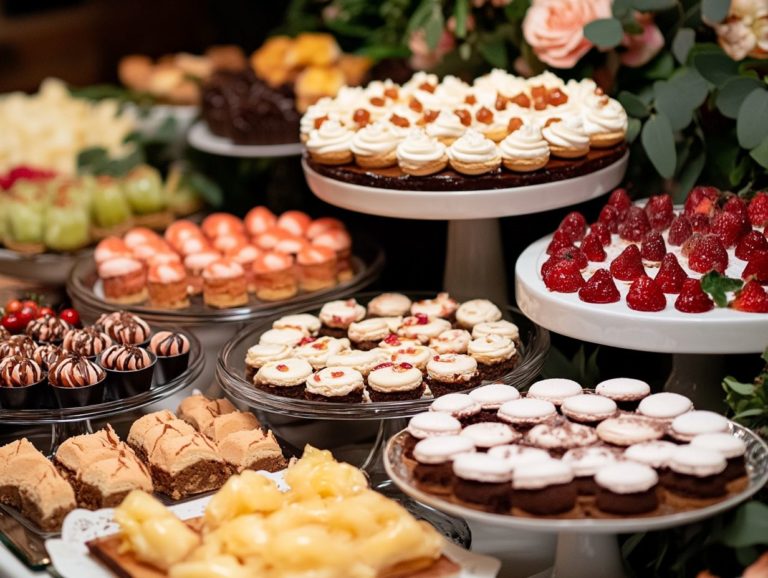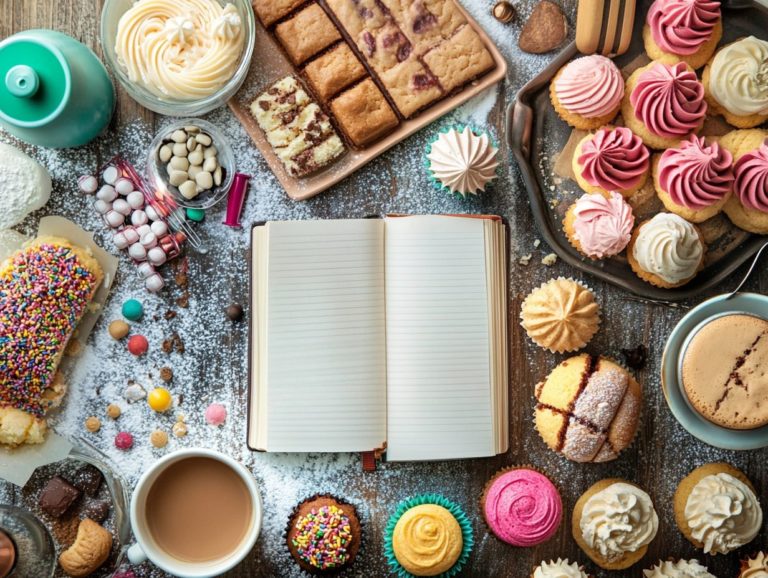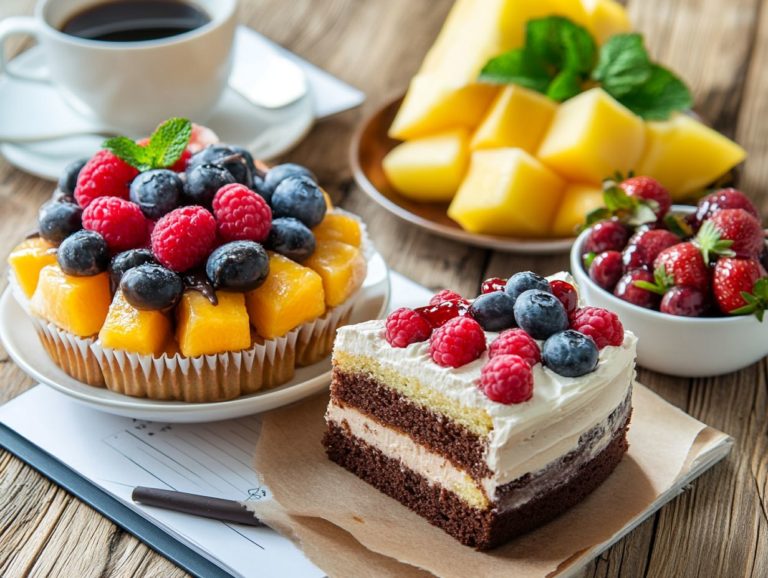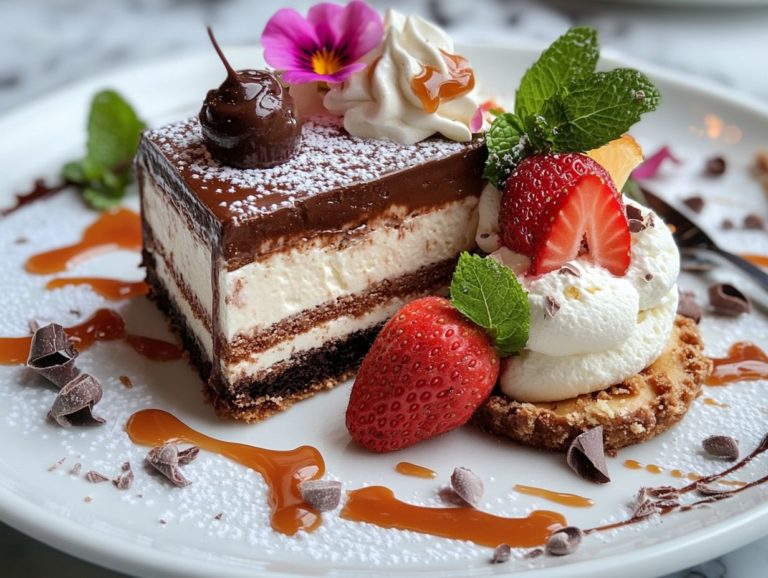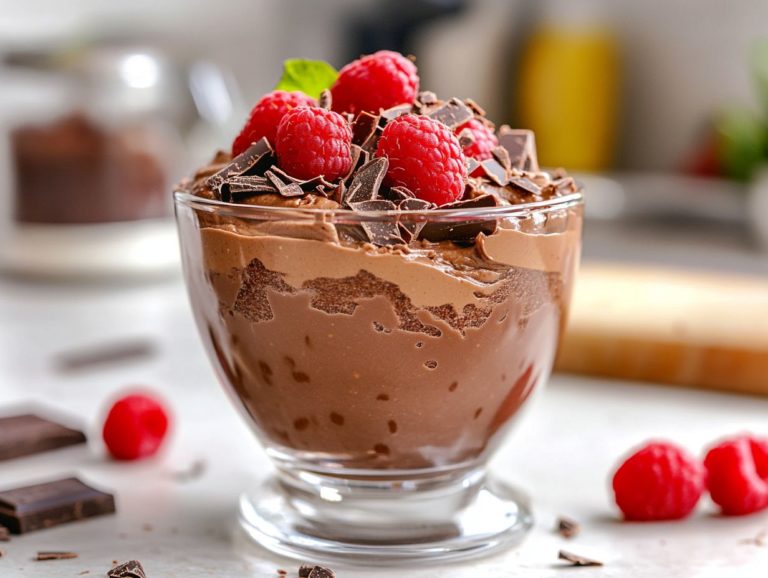How to Use Food Coloring in Desserts?
Contents
- Transform Your Desserts with Food Coloring
- Key Takeaways:
- What are the Different Types of Food Coloring?
- Types of Food Coloring
- How to Use Food Coloring in Desserts?
- What are Some Tips for Using Food Coloring in Desserts?
- Frequently Asked Questions
- How Much Food Coloring Should I Use in Desserts?
- Can I Mix Different Colors of Food Coloring?
- What is the Best Way to Store Desserts with Food Coloring?
Transform Your Desserts with Food Coloring
Food coloring has the power to elevate your desserts from the mundane to the magnificent, adding bright colors that catch the eye and enriching the overall experience.
Whether you’re working on Pastel Deviled Eggs or Gilded Glitter Sugar Cookies, the right coloring can make all the difference.
In this article, you ll explore the diverse types of food coloring at your disposal, ranging from natural and synthetic options to gel and powdered varieties. You ll learn how to effectively incorporate these colors into your baked goods, creating stunning swirls and crafting eye-catching frostings that are perfect for treats like Rainbow Popsicles and Ombre Skewers.
Essential tips will help ensure your creations not only taste delightful but also look visually stunning, from Frozen Yogurt Dots to Rainy Day Cupcakes.
Jump into the vibrant world of food coloring and transform your desserts!
Key Takeaways:
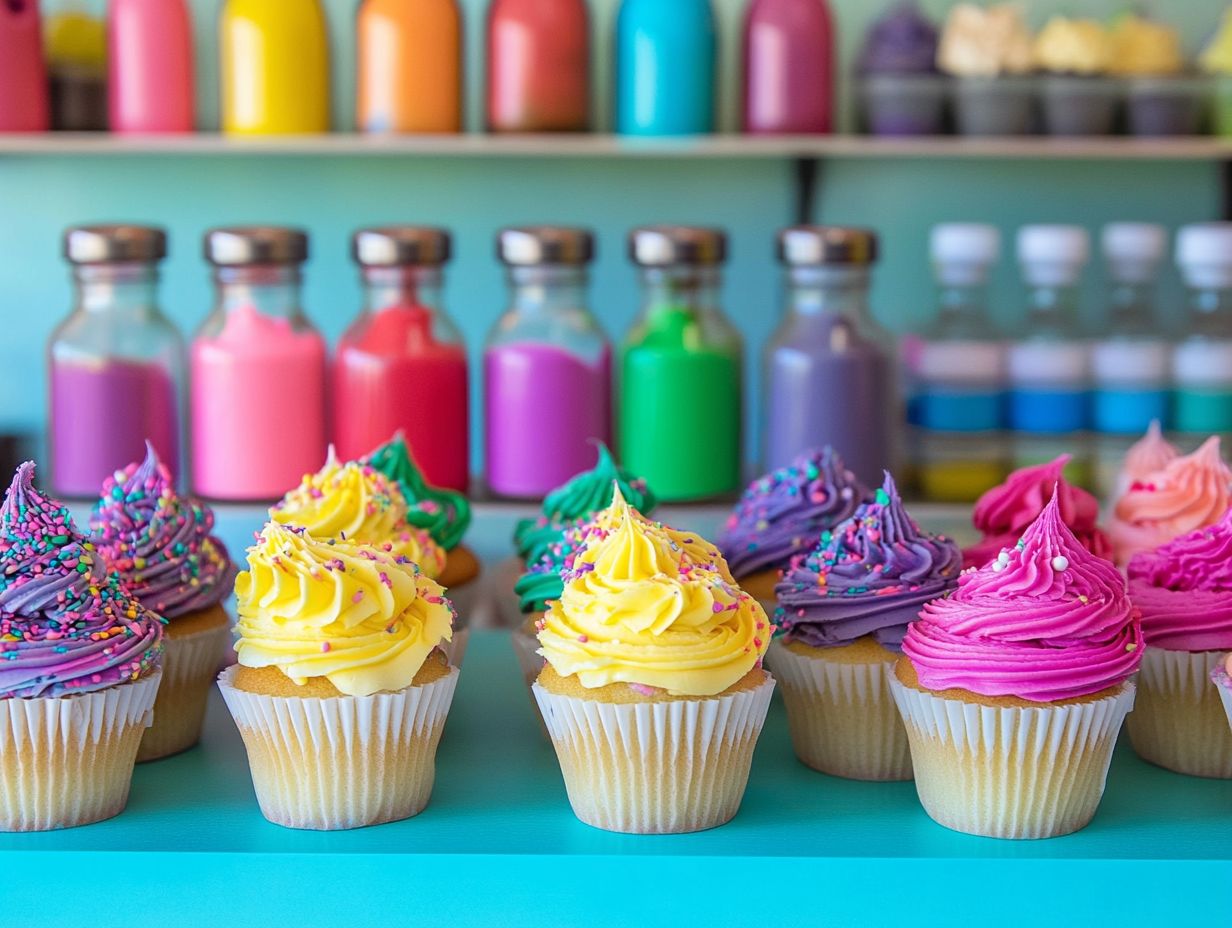
Experiment with different types of food coloring to achieve desired results, such as natural, synthetic, gel, or powdered. Consider trying Chefmasters Candy Colors or Liqua-Gel for vibrant and consistent results.
Get creative with food coloring by adding it to baked goods, creating swirls and patterns, making colored frosting, and coloring chocolate and candy.
Remember to start with a small amount of food coloring, mix colors to create custom shades, consider using natural alternatives, and be mindful of color changes during baking.
What are the Different Types of Food Coloring?
Food coloring plays a vital role in the culinary arts, especially in the realms of baking and dessert decoration. It enables you to elevate the visual allure of your creations, whether you’re making Polka-Dot Cake or Candy Corn Push-Up Pops.
Among the myriad types of food coloring available, you ll discover:
- Natural options derived from plant extracts,
- Synthetic varieties that deliver vibrant and consistent hues,
- Gel food coloring, which is a concentrated color that doesn t change the consistency of your cake batter or icing,
- Powdered food coloring, offering versatility for a range of applications.
By understanding these different types of food coloring, you can significantly enhance your dessert presentations, transforming everything from a delightful Polka-Dot Cake to stunning Rainbow Layered Rice Krispie Treats or Speckled Egg Cookies.
1. Natural Food Coloring
Natural food coloring, sourced from plants, offers you vibrant hues without resorting to synthetic additives. This makes it an excellent choice for health-conscious bakers and chefs who wish to create stunning desserts like Rainbow Popsicles, Fruit-Dyed Layer Cake, and Pantone Easter Eggs.
To obtain these natural colors, you can extract pigments from everyday ingredients. For instance, beet juice provides a striking red, while turmeric adds a luxurious golden yellow to your creations. Spirulina, a blue-green algae, brings a unique teal shade to the table, making it perfect for imaginative culinary endeavors.
Using these natural colors not only enhances the visual appeal of your recipes but also aligns beautifully with a health-focused lifestyle, making them perfect for dishes like Lavender French Macarons and Oreos Dipped in Colored Chocolate.
When you incorporate these vibrant and pastel colors into your delightful treats, you elevate the visual experience of your desserts, capturing attention and pleasing palates in the process.
Types of Food Coloring
2. Synthetic Food Coloring
Synthetic food coloring is a staple in the baking industry, renowned for its ability to deliver vibrant colors and consistent results essential for crafting visually stunning desserts like:
- Hot Pink Texas Peanut Patties,
- Funny Marshmallow People,
- Crispy Cereal Marshmallows.
These lively hues not only elevate the visual appeal of your confections but also provide superior color stability across various baking conditions. Unlike natural food coloring, which may lose its vibrancy or alter during the cooking process, synthetic options retain their brilliance, ensuring that your creations remain striking from oven to table.
For example, when you whip up beloved recipes like:
- tie-dye cupcakes,
- rainbow-layered cakes,
- Pastel Peppermint Patties,
the use of synthetic colors guarantees that each layer pops with intensity, making it an ideal choice for bakers eager to leave a lasting impression. Synthetic food coloring also offers an extensive spectrum of shades, allowing for precise customization as you craft your unique treats.
3. Gel Food Coloring
Gel food coloring has become your go-to choice as a baker, providing a concentrated coloring option that allows you to create vibrant hues without thinning out your icing or cake batter. This makes it perfect for decorating delightful treats like:
- Rainbow Bread,
- Ombr Skewers,
- Candy Corn Cake.
This remarkable quality is why gel food coloring is particularly popular for intricate designs and detailed decorations, enabling you to achieve the precise shades you desire. Brands like Chefmaster and Chefmasters Natural Food Colors offer an impressive range of colors that blend effortlessly into various recipes, from cupcakes to royal icing. Unlike their liquid counterparts, gel versions maintain the integrity of your mixture, ensuring that your sweets retain their intended texture.
As a creative baker, you ll find that just a small amount of gel color can go a long way, allowing you to achieve stunning results with minimal product. This is ideal whether you re an amateur or a professional looking to elevate your culinary creations.
4. Powdered Food Coloring
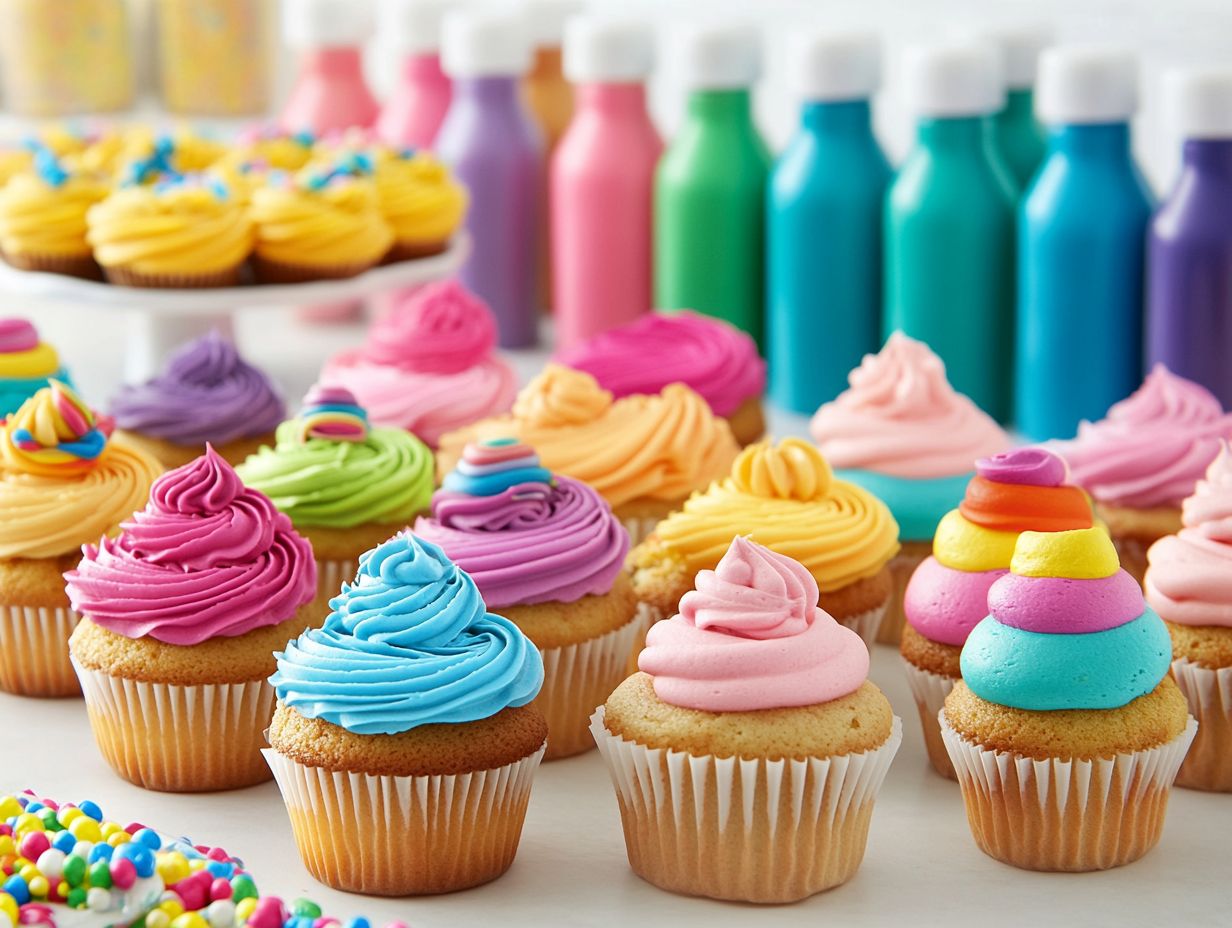
Powdered food coloring is a versatile choice that enables you to achieve bright colors without introducing excess liquid into your recipes, making it perfect for projects like:
- Stamped Fondant Cookies,
- Dip-Dyed Cupcake Liners,
- Stamped Marshmallows.
This innovative coloring method provides you with the flexibility to blend seamlessly with other ingredients, allowing you to create custom shades that align perfectly with any theme or occasion. For example, when you’re crafting colorful macarons or frosting for cakes, you ll love how easily you can adjust the intensity by changing the amount of powdered coloring you use.
Choosing natural food coloring appeals to health-conscious consumers who prefer to avoid synthetic additives. Alternatively, airbrush food coloring is a liquid dye that can be sprayed onto desserts for a smooth finish. Whether you’re enriching the appearance of delicate bridal shower desserts or enhancing the festive spirit of birthday treats like M&M Pi ata Cookies and Vanilla Blackberry-Mascarpone Cake for Two, powdered food coloring proves to be a critical tool for your artistic culinary creations.
How to Use Food Coloring in Desserts?
Using food coloring in desserts is truly an art form that can elevate the visual appeal and overall enjoyment of your sweet creations, turning ordinary baked goods into vibrant masterpieces. Whether you re adding a splash of color to cake batter for an eye-catching Polka-Dot Cake, crafting mesmerizing swirls with Ombre Skewers, or designing colorful frosting for Dream Cookies and Rock Candy Cupcakes, mastering the techniques for incorporating food coloring is essential for any baker.
Grasping the nuances of food coloring can unlock a realm of creativity in your baking, allowing you to bring to life delightful treats like Lavender French Macarons, M&M Pi ata Cookies, and Pastel Meringue Bird Nests.
So grab your food coloring and let your creativity shine you won t believe the delicious masterpieces you can create!
1. Adding Color to Baked Goods
Enhancing the visual appeal of your baked goods is a simple yet powerful technique, especially when it comes to delightful treats like Rainbow Layered Rice Krispie Treats, Polka-Dot Cheesecake Brownies, or Homemade Gum Drops. By incorporating food coloring directly into the cake batter or dough, you can achieve stunning results.
To ensure your colors are vibrant and evenly distributed, opt for gel or paste food coloring. These are concentrated hues that outperform their liquid counterparts, delivering the bold shades you desire. Start by adding just a few drops to your mixture and blend thoroughly until you reach the perfect shade.
For more intricate recipes, like a marble cake, consider dividing the batter into separate bowls and tinting each portion individually. Then, swirl them together for a beautiful marbled effect.
Always remember to mix gently especially with delicate mixtures, like those in meringue-based desserts. This approach not only enhances the visual appeal but also preserves the texture of your final creation.
2. Creating Swirls and Patterns
Creating swirls and patterns in your desserts is an exhilarating technique that infuses an artistic touch into your baking. This results in stunning visual effects for cakes, cookies, and an array of delightful sweets, such as vibrant Rainbow Popsicles or captivating Pastel Meringue Bird Nests.
By employing methods like marbling where you gently swirl contrasting colors of batter together with a skewer or layering various shades of frosting, you can conjure mesmerizing effects that truly captivate the eye. Incorporating food coloring not only amplifies these designs but also opens the door to endless creativity. Imagine taking a rich chocolate cake and jazzing it up with vibrant swirls of raspberry or refreshing mint green icing.
Don t shy away from experimenting with different textures by combining elements like whipped cream or ganache, which is a rich chocolate mixture that adds a luxurious touch to your desserts. This will elevate the visual appeal while ensuring that every bite is a delightful experience, just like in Pastel Peppermint Patties or Color Dipped Marshmallows.
3. Making Colored Frosting
Creating colored frosting is a fun and vibrant way to elevate your desserts! It allows both flavors and colors to stand out in your creations, such as Rainbow Slice and Bake Cookies, Rock Candy Cupcakes, or Oreos Dipped in Colored Chocolate. Each bite transforms into a visual masterpiece.
To get started, gather your essential frosting ingredients, which typically consist of butter, powdered sugar, milk, and vanilla extract. Once you have your perfect base, it s time to select the type of food coloring. Gel food coloring, like Chefmasters Candy Colors and Liqua-Gel, is often the go-to choice for its rich pigments and minimal impact on frosting texture.
When aiming for lighter shades, begin with just a dab of color and gradually mix in more until you reach your desired hue. While liquid food coloring is an option, proceed with caution, as it can thin your frosting more than you’d like. As you play with different shades, think about how they will enhance your dessert styles perhaps pastel colors for your delicate Vanilla Bean Cupcakes or vibrant tones for your festive birthday cakes and Rainbow Popsicles.
4. How to Color Chocolate and Candy
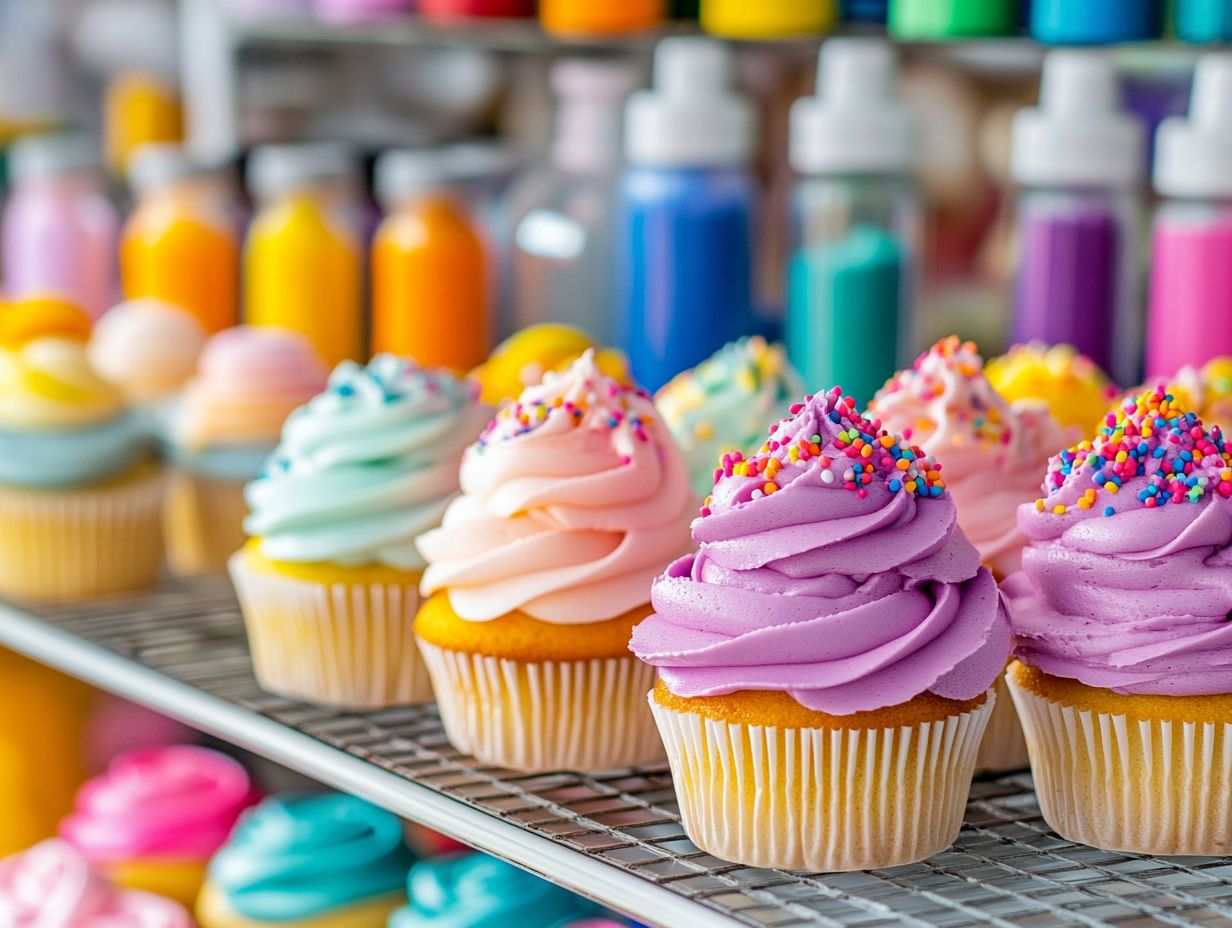
Coloring chocolate and candy can elevate your ordinary treats into extraordinary delights, allowing you to craft festive designs for occasions like Easter. Imagine creating vibrant masterpieces such as Candy Corn Push-Up Pops, Stamped Marshmallows, or Oreos Dipped in Colored Chocolate that will leave everyone in awe.
When selecting food coloring, opt for gel or oil-based colors specifically formulated for candy making. These options offer superior color intensity and blend effortlessly into melted chocolate or candy melts. To achieve that rich hue without compromising texture or flavor, begin by adding a small amount. Gradually increase as needed while stirring thoroughly.
And don t forget to temper your chocolate this step keeps it smooth and prevents that pesky blooming.
When making candy, consider incorporating the coloring during the cooling process. This technique captures brilliant colors that make your treats pop!
What are Some Tips for Using Food Coloring in Desserts?
When you incorporate food coloring into your desserts, adhering to a few essential tips can elevate your creations, ensuring they not only captivate the eye but also preserve their intended flavors and textures.
By grasping how different types of food coloring interact with various ingredients and being aware of how colors may shift during baking, you can achieve stunning results with your sweet masterpieces.
Whether you’re crafting delectable Frozen Yogurt Dots, Funny Marshmallow People, or delightful Crispy Cereal Marshmallows, these insights are tailored to help you excel in your baking endeavors.
1. Start with a Small Amount
When you embark on your journey with food coloring, it’s crucial to start with just a small amount to assess the intensity of color you want to achieve. This is especially important in delicate desserts like Lavender French Macarons or Polka-Dot Cake. Too much color can easily overwhelm the overall appearance.
This careful approach helps you attain the desired hue while maintaining the integrity of the flavors that are the essence of these desserts. As you progress, gradually incorporating more color gives you better control over the final outcome.
This technique ensures that the visual appeal perfectly complements the taste, resulting in a balanced dessert that delights the eye without compromising its deliciousness. Consider making Polka Dot Cheesecake Brownies for a fun and colorful treat.
Whether you’re going for a striking fuchsia in a floral cupcake or a subtle blush in a cream cheese frosting, the art of coloring requires both patience and precision. By taking it slow, you can introduce a more vibrant palette while keeping your beloved recipes intact.
2. Mix Colors to Create Custom Shades
Mixing colors enables you to create custom shades that perfectly complement your dessert themes, unlocking a world of creative possibilities for vibrant creations like Stamped Fondant Cookies, Rainbow Layered Rice Krispie Treats, or Rainbow Slice and Bake Cookies.
By experimenting with primary colors and investigating various combinations, you can achieve a lively palette that elevates the visual appeal of any baked item. For example, blending red and yellow can produce stunning shades of orange, ideal for autumn-themed treats, while a touch of blue can yield soothing hues perfect for summer desserts.
Opting for gel food coloring offers greater intensity compared to liquid alternatives, allowing you the flexibility to adjust shades with remarkable precision. Whether you’re working with frosting, fondant, or batters, the ability to customize colors based on the occasion opens up a realm of unique artistic expression in your baking.
In conclusion, the art of coloring allows you to enhance your desserts in exciting ways. Don’t hesitate to experiment with colors and techniques to find what works best for your recipes. Happy baking!
3. Use Natural Alternatives
Embracing natural alternatives to synthetic food coloring allows you to achieve vibrant hues while preserving the integrity of your ingredients. This approach is ideal for health-conscious bakers eager to craft delightful treats like Pastel Peppermint Patties, Speckled Egg Cookies, or Gilded Glitter Sugar Cookies.
These alternatives not only enhance the visual allure of your desserts but also boost their nutritional value. For instance, beet juice lends a stunning red tone, while turmeric imparts a brilliant yellow shade, both sourced from whole, unprocessed ingredients. Spirulina adds a unique blue-green color, perfect for captivating visuals, effortlessly blending into your frostings or batters.
By incorporating these natural colorants, you can elevate your baking creatively, transforming classic recipes into impressive, vibrant masterpieces all while ensuring they remain free from synthetic additives and preservatives.
4. Be Mindful of Color Changes during Baking

As a baker, it’s essential to recognize that colors can transform during the baking process, often fading or shifting tones. This understanding makes planning ahead vital for achieving the perfect results in your delightful creations, whether it’s Polka-Dot Cheesecake Brownies, Rainy Day Cupcakes, or Lavender French Macarons.
Different types of food coloring react in unique ways when exposed to heat, which can significantly impact the final appearance of your treats. For instance, gel colors are renowned for their ability to maintain vibrancy better than their liquid counterparts, making them a favored choice for intricate designs in cakes and pastries. On the other hand, natural colors sourced from beet juice or turmeric may either fade or deepen when subjected to high temperatures. Using Chefmasters Natural Food Colors can provide a more stable natural alternative.
When you embark on a baking adventure with Rainbow Layer Cakes, grasping these subtleties will be crucial in ensuring that each layer retains its intended hue. Don’t overlook the importance of the recipe’s baking temperature and time, as these elements play pivotal roles in color stability and the overall aesthetic of your creations. Additionally, consider experimenting with airbrush food coloring for more intricate designs and smoother gradients.
Frequently Asked Questions
How do I use food coloring in desserts?
To use food coloring in desserts, start by choosing the type of food coloring you want to use – liquid, gel, powder, or natural dyes. Then, add small amounts of coloring at a time until you reach the desired color. It’s important to mix the coloring well to ensure an even distribution.
To use food coloring in desserts, start by choosing the type of food coloring you want to use – liquid, gel, or powder. Then, add small amounts of coloring at a time until you reach the desired color. It’s important to mix the coloring well to ensure an even distribution.
What type of food coloring is best for desserts?
The type of food coloring you use for desserts depends on the recipe and your personal preference. Liquid food coloring is best for light, pastel colors, while gel and powder food coloring are better for achieving vibrant and deep colors. Natural food coloring is a great option for those looking to avoid artificial ingredients.
The type of food coloring you use for desserts depends on the recipe and your personal preference. Liquid food coloring is best for light, pastel colors, while gel and powder food coloring are better for achieving vibrant and deep colors.
Can I use natural food coloring in desserts?
Yes, you can use natural food coloring in desserts. Natural food coloring is made from plant-based ingredients and can be found in powdered or liquid form. It may not be as vibrant as artificial food coloring, but it’s a great option for those looking to avoid artificial ingredients. Chefmaster s Natural Food Colors are a popular choice.
Yes, you can use natural food coloring in desserts. Natural food coloring is made from plant-based ingredients and can be found in powdered or liquid form. It may not be as vibrant as artificial food coloring, but it’s a great option for those looking to avoid artificial ingredients.
How Much Food Coloring Should I Use in Desserts?
The amount of food coloring you use depends on the recipe and the color intensity you desire. Start with a few drops and adjust as needed.
Can I Mix Different Colors of Food Coloring?
Yes! Mixing different colors of food coloring lets you create custom shades. For the best results, mix them in a separate container first, then add to your dessert mixture.
What is the Best Way to Store Desserts with Food Coloring?
Cover desserts tightly and store them in a cool, dark place. Keep them out of direct sunlight to prevent fading. For longer shelf life, refrigerate them if possible.
